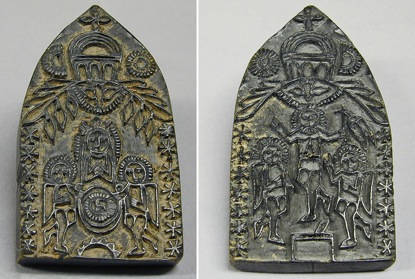Wooden tattooing stamp
Armenia, before 1910
 Purchased from K. Marian Reynolds in 1910; 1910.71.1This is a double-sided stamp that the tattoo artist uses to print a design on the skin, providing him with a guide. The designs show Christian themes; on one side (shown on the left) is a woman with her hands clasped in prayer. She is flanked by two angels who each hold the end of a piece of cloth in which is cradled an man's head. This probably represents Saint Veronica, either with the head of John the Baptist or the veil with which she famously wiped the face of the Suffering Christ on his way to Cavalry. On the reverse side (shown on the right) is an image of the Resurrection. Christ has risen from the tomb, flanked either side by angels and above his head are the images of the sun, moon, dove of peace, and a chapel. The woodblock itself is shaped like the arch of a church door or window.
Purchased from K. Marian Reynolds in 1910; 1910.71.1This is a double-sided stamp that the tattoo artist uses to print a design on the skin, providing him with a guide. The designs show Christian themes; on one side (shown on the left) is a woman with her hands clasped in prayer. She is flanked by two angels who each hold the end of a piece of cloth in which is cradled an man's head. This probably represents Saint Veronica, either with the head of John the Baptist or the veil with which she famously wiped the face of the Suffering Christ on his way to Cavalry. On the reverse side (shown on the right) is an image of the Resurrection. Christ has risen from the tomb, flanked either side by angels and above his head are the images of the sun, moon, dove of peace, and a chapel. The woodblock itself is shaped like the arch of a church door or window.
The relationship between tattooing and Christian Church has been an uneasy one. The Old Testament expressly prohibited the practice, a sentiment echoed by Saint Basil the Great in the 4th century AD:
"No man shall let his hair grow long or tattoo himself as do the heathen, those apostles of Satan who make themselves despicable by indulging in lewd and lascivious thoughts. Do not associate with those who mark themselves with thorns and needles so that their blood flows to the earth."
However, early Christians were often tattooed on the face as a punishment by the Roman authorities and after the rise of Christianity, followers sometimes tattooed themselves voluntarily to mirror the wounds of Christ on his hands and feet (or 'stigmata', which was also the Roman word for 'tattoo'). An edict issued by the Council of Northumberland several centuries later in AD 787 distinguished between acceptable Christian tattoos and 'profane' tattoos worn by pagan Britons. According to the Church Fathers:
"When an individual undergoes the ordeal of tattooing for the sake of God, he is greatly praised. But one who submits himself to be tattooed for superstitious reasons in the manner of the heathens will derive no benefit there from."
By the Middle Ages, mentions of tattooing become more frequent in the Christian record. Some devout friars and clerics wore tattoos to demonstrate their faith and there were stories of tattoos appearing on the body miraculously, as in the case of the exorcism of a German girl in 1501. Most notably in the medieval period, pilgrims and crusaders to the Holy Land had crosses tattooed on their arms and hands as souvenirs and evidence of their travels. The tradition of the pilgrimage tattoo continued although by the 18th century it had largely died out among Latin Christians and was taken up instead by the Coptic Orthodox community that had originated in Egypt.
In the 1950s a professional tattooist named Jacob Razzouk in Jerusalem's Old Town was using olive-wood pattern blocks like this that had been used by his family to tattoo pilgrims for several hundred years. They were mostly based on Coptic imagery although his customers evidently included members of many denominations due to the mix of Egyptian, Armenian, Latin, Syrian Slav and Hebrew designs in his collection. The pilgrim 'season' peaked at Easter (part of the purpose of the woodblock was to save the tattooist time during this busy period) so Razzouk made his living the rest of the year by making coffins. In 2002, the Razzouk family was still practising tattooing in Jerusalem although they considered it a dying art since their descendents had no desire to learn the trade and troubles in the region had resulted in a drop in the number of tourists and pilgrims to the city.
